-
The BladeForums.com 2024 Traditional Knife is available! Price is $250 ea (shipped within CONUS).
Order here: https://www.bladeforums.com/help/2024-traditional/
You are using an out of date browser. It may not display this or other websites correctly.
You should upgrade or use an alternative browser.
You should upgrade or use an alternative browser.
Paul sellers technique
- Thread starter 80sskater
- Start date
It's about as good as any other fixed angle sharpening system. Yes, you would need to measure the height of the support and the length of the stone and then do trig in order to find the angle.
The truth is, the absolute angle doesn't matter nearly as much as having a fully formed clean edge. As long as that angle is in a reasonable range, the blade is going to be sharp. Of course you can almost always do better by using a smaller angle. But a well formed edge at ~15 to 20 degrees per side is going to work well for a huge array of blades.
Brian.
The truth is, the absolute angle doesn't matter nearly as much as having a fully formed clean edge. As long as that angle is in a reasonable range, the blade is going to be sharp. Of course you can almost always do better by using a smaller angle. But a well formed edge at ~15 to 20 degrees per side is going to work well for a huge array of blades.
Brian.
- Joined
- Apr 12, 2009
- Messages
- 13,495
I'm sure it can work. The angle will vary a bit as the back end of the hone, sliding on the table, moves closer to or further from the blade's edge. But as Brian mentioned, that isn't necessarily a big deal. You should still be able to form a crisp apex, and the bevels behind it will convex a little bit. It would be the same with a freehand-sharpened edge as well.
I'd also likely use something a little thinner for the blade support, to get the angle a little more acute*. (* EDIT: This may not be necessary, as the length of the 'paddle' arm keeps the angle pretty acute, even with the 3/4" blade support.) Alternatively, one could also increase the length of the 'paddle' for the honing medium, which would place the back end of the hone/paddle further away and lower the angle. The longer 'arm' of the paddle could also work to narrow the variation in angle and flatten out the convex a little bit, assuming the length of the sharpening stroke remains about the same.
I may have to play with this a bit, just to see what it can do. I can see, one advantage to this method is the forward end of the hone can't or won't accidentally drop too far and leave some ugly scratches above the bevel shoulders, so long as the back end of the paddle stays firmly on the table. Might help in making some more uniform-looking bevels for those of us ( ) whom occasionally get a little sloppy with angle control in freehand.
) whom occasionally get a little sloppy with angle control in freehand.
I'd also likely use something a little thinner for the blade support, to get the angle a little more acute*. (* EDIT: This may not be necessary, as the length of the 'paddle' arm keeps the angle pretty acute, even with the 3/4" blade support.) Alternatively, one could also increase the length of the 'paddle' for the honing medium, which would place the back end of the hone/paddle further away and lower the angle. The longer 'arm' of the paddle could also work to narrow the variation in angle and flatten out the convex a little bit, assuming the length of the sharpening stroke remains about the same.
I may have to play with this a bit, just to see what it can do. I can see, one advantage to this method is the forward end of the hone can't or won't accidentally drop too far and leave some ugly scratches above the bevel shoulders, so long as the back end of the paddle stays firmly on the table. Might help in making some more uniform-looking bevels for those of us (
Last edited:
Wowbagger
Gold Member
- Joined
- Sep 20, 2015
- Messages
- 8,036
As with many things Paul Sellers I find there are BETTER more fun ways of doing things than what he offers. I think he has a high BS tolerance and just stops investigating and uses the first thing he comes across that does the job even if it is slow, tedious and not fun making up the slack with "hard work".
When I first saw this thread title I figured I was going to see a vid with him stropping the thing to death like he does his woodworking plane blades.
Obviously his technique works BUT it is a get-by and really isn't a knife knut sort of thing. Using a longer stone with just a few strokes is a better way to go. All the roundy round is just tedious and slow especially on harder steel.
Let me give an example that is totally off topic.
Note his bench vise in the video above. I have that vise. It costs hundreds of dollars and I was all about it back in the day. Once I bought one and mounted it to my bench and used it I came to call it "The Rails In The Way Vise". I couldn't wait to have something MUCH better. I used it to make myself a real woodworker's bench with a face vise and a tail vise and The Rails In The Way Vise just gathers dust and acts as ballast to keep my shop from blowing away in a high wind.
(That was an attempt at humor)
Rails in the way =
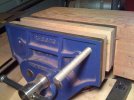
How does he hold a drawer to plane it ? I suppose he has some tedious work around but why not just use the best tool for the job such as my vise which I learned about from Frank Klausz shown using his here.
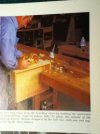
My tail vise
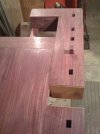
My face vise
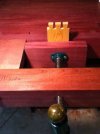
My knife sharpener
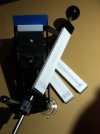
I do use those diamond paddles that he recommends for my portable emergency sharpening kit but only to sharpen little cobalt drill bits and cutters. Never a knife.
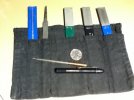
When I first saw this thread title I figured I was going to see a vid with him stropping the thing to death like he does his woodworking plane blades.
Obviously his technique works BUT it is a get-by and really isn't a knife knut sort of thing. Using a longer stone with just a few strokes is a better way to go. All the roundy round is just tedious and slow especially on harder steel.
Let me give an example that is totally off topic.
Note his bench vise in the video above. I have that vise. It costs hundreds of dollars and I was all about it back in the day. Once I bought one and mounted it to my bench and used it I came to call it "The Rails In The Way Vise". I couldn't wait to have something MUCH better. I used it to make myself a real woodworker's bench with a face vise and a tail vise and The Rails In The Way Vise just gathers dust and acts as ballast to keep my shop from blowing away in a high wind.
(That was an attempt at humor)
Rails in the way =

How does he hold a drawer to plane it ? I suppose he has some tedious work around but why not just use the best tool for the job such as my vise which I learned about from Frank Klausz shown using his here.

My tail vise

My face vise

My knife sharpener

I do use those diamond paddles that he recommends for my portable emergency sharpening kit but only to sharpen little cobalt drill bits and cutters. Never a knife.

Last edited:
- Joined
- Sep 23, 2014
- Messages
- 1,287
Hi,I meant measure the angle
See degree-wedges.1481595/#post-17047271 and degree-wedges.1481595/#post-17047737 for improvement ideas/pictures/math.
(stack wood , "rise", raise off table, backstop/shim blade, use 1:60 angle estimation rule, put a splint on your stone , and you've got edge pro apex ).
The "table" in the picture doesnt have to be your actual table

Hi,As with many things Paul Sellers .. just stops investigating .. Obviously his technique works BUT it is a get-by and really isn't a knife knut sort of thing. Using a longer stone with just a few strokes is a better way to go. All the roundy round is just tedious and slow especially on harder steel.
IMHO his video is made for audience of kids ... to grandmothers, who dont want to learn a lot about sharpening who think its difficult. I like it.
Its a step above binder clips as angle guides in sharpening howto knowledge,
its for for those who want to know just a little more howto,
a simple two - five dollar craft project (dollar store sandpaper and popsicle sticks / ruler / glue )
with room for improvement for those that get inspired to go full triangle and make a popsicle stick lansky or edge pro.
- Joined
- Jun 4, 2010
- Messages
- 6,642
Sellers has solid advice and tips. (period). The more you look the more you learn - it works.
Wowbagger
Gold Member
- Joined
- Sep 20, 2015
- Messages
- 8,036
But there is still that AWFUL vise.Sellers has solid advice and tips. (period). The more you look the more you learn - it works.
Wowbagger
Gold Member
- Joined
- Sep 20, 2015
- Messages
- 8,036
Here's what I was talking about with all the stropping not to mention lots of wasted strokes that are only abrading way up on the bevel and not on the edge. Why is that a problem ? Wears the stone, loads the stone with swarf . . . does nothing for the edge until he rocks the chisel down to the edge and starts to push forward THEN he is actually sharpening.
Thirty strokes on the strop with lots of body weight he says.
Plus all the stokes on the three diamond plates.
That's old school stuff.
I could sharpen the same edge on five STONES . . . six strokes per stone . . . with far less effort (no need to put lots of body weight on anything) . . . zero stropping . . . zero TEARING THE BUR OFF and get a better geometry with far less effort and stone wear / clogging swarf . . . because . . . I am right on the edge THE WHOLE TIME with both the push and the pull stroke.
I use a simple jig. Saves a lot of rocking and stone cleaning and energy.
Thirty strokes on the strop with lots of body weight he says.
Plus all the stokes on the three diamond plates.
That's old school stuff.
I could sharpen the same edge on five STONES . . . six strokes per stone . . . with far less effort (no need to put lots of body weight on anything) . . . zero stropping . . . zero TEARING THE BUR OFF and get a better geometry with far less effort and stone wear / clogging swarf . . . because . . . I am right on the edge THE WHOLE TIME with both the push and the pull stroke.
I use a simple jig. Saves a lot of rocking and stone cleaning and energy.
